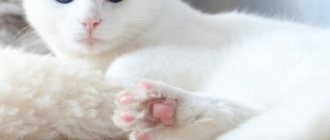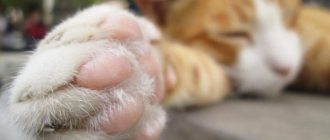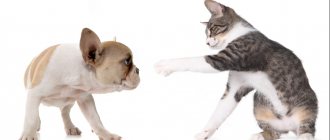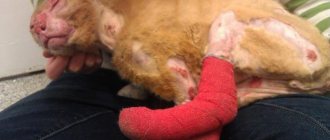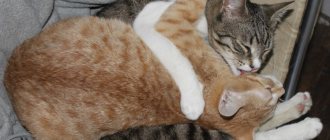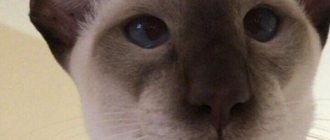Lameness in cats does not appear just like that; there are always reasons that cause it. If a pet has a slight limp, and this defect goes away after 1-2 days, he could have hurt her. This often happens in sedentary and overweight cats. When the animal does not step on its hind paw at all, it must be carefully examined for damage. The cat's reaction to the examination will prompt further actions. Severe pain in response to any touch will force her to become aggressive. The cat will begin to struggle, bite, and meow loudly. This means that serious injuries, including fractures, or dangerous diseases cannot be ruled out. She needs to be shown to a veterinarian.
How to distinguish a fracture from a bruise on the hind leg
The cat limps on its hind leg without visible damage due to fractures, cracks in the bones, sprains, dislocations, or severe bruises. At the same time, it is completely impossible to distinguish a fracture from a crack at home.
A pet can limp for a variety of reasons.
With fractures and cracks in the bone, the pet does not lean on the sore paw at all, but constantly holds it suspended. Tries to move less. When trying to examine, he does not allow you to touch the sore limb. Swelling and increased temperature may be observed at the site of injury.
As first aid, the limb must be immobilized by applying a cardboard splint and securing it with a bandage. Trying not to disturb the sore paw, you need to take the cat to the veterinary clinic. After an x-ray and a detailed examination, specialists will apply a plaster cast or splint, depending on the severity of the injury.
An x-ray will show the presence of a fracture
Unlike a fracture, with bruises, the cat sometimes leans on the damaged paw, even if there is some swelling. When palpated, the injured limb causes pain. After 1-2 days, the ward will begin to rely on her more and more often. Soon the lameness will completely go away.
First aid for a cat
If you notice that your cat is limping, you need to immediately identify the cause. Having discovered a wound, the first thing to do is disinfect it. If possible, remove hair around the damage and rinse with furatsilin solution.
Limit access of dirt to the wound, apply a bandage and contact a veterinarian.
If you suspect a dislocation, sprain or fracture, provide your pet with maximum rest, give painkillers and cardiac medications, and call a doctor.
X-ray of the hind paw.
An x-ray must be taken at the clinic . If necessary, apply a fixing bandage. The fracture is fixed by applying a splint or plaster cast. Antibiotics and anti-inflammatory drugs are used.
Arthritis treatment
Treatment of arthritis includes taking antibiotics in the form of a dietary supplement - glucosamine, chondroitin.
Taking fish oil and painkillers. A light massage and daily short exercise are indicated. Animals with arthrosis are provided with dietary nutrition and comfortable living conditions.
Drug treatment - decongestants, anti-inflammatory drugs - in the presence of inflammation. Massage, Minin lamp therapy. For severe back injuries, the prognosis is, unfortunately, unfavorable. The animal experiences severe pain, and sometimes limb paralysis is observed.
Back or brain injury and their consequences
The dog is limping on its hind leg with no visible damage.
Unfortunately, more severe injuries resulting from cats falling from a great height (from a balcony, roof) are fraught with bruises, concussion of the brain and spinal cord with subsequent neurological disorders. In addition, they may be accompanied by numerous fractures of the musculoskeletal system.
For your information! A strong blow to the head leads to the destruction of brain cells, and the hypothalamus and brain stem may be damaged. In especially severe cases, cerebral hemorrhages and tissue necrosis occur.
When the spinal cord is contused, a disruption in the functioning of the musculoskeletal system occurs, the animal limps or completely loses the ability to move. Vomiting occurs, the pupils often have different sizes, and they react poorly or not at all to light. The cat begins to spontaneously shake its limbs. The head may fall back, and the pet may lose consciousness or fall into a coma.
Important! The cat's symptoms and behavior depend on how severely the animal is injured. In severe forms with rupture of the spinal cord membranes, the sensitivity of the limbs and tail is completely lost.
If the cat is unconscious or in shock, under no circumstances should you shake it or apply ammonia to its nose. You need to make sure that the tongue is not stuck and take it to the veterinarian in your arms. Only a specialist can assess the degree of concussion. Depending on the situation, he will give the necessary injections of antibiotics and sedatives. In some cases, the use of medications to support heart function will be required. The doctor will give the necessary recommendations for care and treatment. The recovery of a cat is long, up to 4-8 weeks or more (depending on the age of the animal and the severity of the condition).
The presence of serious diseases that cause lameness can only be detected by a veterinarian
Providing first aid for a concussion in a pet
If the cat received a blow to the head area and there is a suspicion that she has a concussion, then you need to bring her into a room with dim lights and put her down. If the symptoms do not disappear within ten minutes, then you should definitely seek advice from a specialist. Large cities usually have a 24-hour veterinary clinic.
In case of loss of consciousness, you must follow the following algorithm:
- do not try to stir up the animal or lay it on its side;
- in case of tongue retraction, ensure its straightening;
- Apply dry cold to the injury site;
- make a cold compress on the head (wet a towel in cold water, fold it several times and place it on the animal’s head);
- if there is an open wound, you need to stop the bleeding and apply a bandage;
- if vomiting begins, make sure that the cat does not choke on the mass;
- in case of cessation of breathing, it is recommended to perform indirect cardiac massage and artificial respiration.
Among the drugs that can be used without consulting a doctor, use an injection of caffeine and camphor. But it’s better not to treat a cat’s concussion on your own. The symptoms should prompt you to see a specialist.
Joint diseases
The cat is limping on its front leg without visible damage
Also, without visible damage, the cat limps on its hind leg with serious joint diseases. Some of them are congenital and therefore develop slowly. Pathology cannot be detected by a simple examination without medical education. If you pay attention to the accompanying symptoms and promptly contact specialists, the animal can be cured without resorting to surgery.
- Hip dysplasia is a genetic disease. It is dangerous because it can progress even in young cats. Lameness is especially noticeable after prolonged rest (sleep, rest).
- Arthritis and arthrosis are common in older animals. The disease affects bone tissue, causing pathological changes. Due to pain, cats try to move as little as possible, preferring to lie down. They often refuse food and become weak. When palpating swollen joints, they react sharply to pain. The disease may be accompanied by fever.
- Patella patellar luxation, or patellar luxation, is an uncommon problem in cats. It is usually the result of severe trauma, or less commonly a genetic abnormality. It occurs suddenly, causing severe pain in the animal. At the slightest movement of its paw, the cat meows loudly. The injury requires immediate treatment, and in advanced cases, surgery.
Lack of calcium affects the motor functions of kittens
- Osteomyelitis is a disease that occurs in young cats during the phase of active growth and development. Degeneration and partial destruction of bone tissue can affect not only one limb, but all at once. The disease is characterized by acute pain in the pet, which is why even light touches cause aggressive behavior.
- Osteochondrosis, in which pinching and compression of the nerve roots in the spine occurs, causes the animal to limp in any of the four limbs. Wear of the cartilage layer of the intervertebral discs affects the cat’s ability to move easily.
- Osteosarcoma is a malignant neoplasm. Usually it is a pathology of older cats that have crossed the 6-7 year mark.
All of these diseases can only be diagnosed by a doctor at a specialized clinic. They require mandatory treatment with corticosteroids, immunostimulating and painkillers under the supervision of a veterinarian. In severe cases - surgical intervention.
Important! If there is any suspicion of joint disease in cats, you must immediately take your pet to the clinic. Delay or attempts at treatment at home can negatively affect his health and lead to death.
What should the owner do
In case of an open abdominal injury, it is necessary to close the wound with a dense fixing material and urgently call for veterinary help. In case of internal injuries, it is recommended to apply dry cold to the peritoneum and immediately use the services of doctors.
We will help your cat
If you suspect that your pet has suffered an abdominal injury, contact our clinic immediately. We will receive a small patient in offices equipped with modern equipment, or we will come to your home. The veterinarian will conduct an initial examination, provide emergency assistance, perform tests, a comprehensive examination, recommend a course of treatment for the consequences of the injury, and, if necessary, perform surgical intervention. Do not be afraid to entrust the life of your pet to our caring and experienced doctors.
A joint is a complex mechanism that has several “safeties”, ligaments are one of them. A cat sprain is a fairly rare injury, although it only takes one awkward movement to cause one. Striped animals are protected by their natural plasticity, but with metabolic disorders or a lack of microelements, flexible connective tissues “coarse.” In addition, sprains are difficult to diagnose, or rather, to identify based on “vague” symptoms.
Dense fibrous connective tissue, consisting of many fibers, is almost always in “tension” (a tense state). The following types of ligaments are distinguished in the animal’s body:
- Strengthening
– envelop the joint from the front side, limit the angle of flexion of the joint.
- Inhibitory
– connect the bones on the back side of the joint, limit the angle of extension of the limb.
- Guides
– set the amplitude and angle of joint movement.
- Fixing
– hold the internal organs in a physiologically correct position.
When we talk about sprains, we mean injuries to the ligaments of the joint capsules of the limbs. The ligaments that hold the internal organs are also stretched, for example, when falling from a great height and hitting the ground. Connective tissues are literally permeated with nerve endings, so violation of the integrity of the ligaments is always associated with severe pain.
For convenience, ligament injuries were divided into sprains and ruptures. However, in both cases the pain is associated with rupture of the fibers, in the first case the damage is partial, in the second the ligament is completely separated. With a favorable combination of circumstances and timely assistance, fibrous tissue grows together quickly and without medical intervention. The worst-case scenario is hemorrhage into the soft tissues due to increased local pressure.
Lack of vitamins and microelements
The dog is limping on its front leg without visible damage
Due to a lack of calcium and excess fluoride in the pet’s blood, hyperparathyroidism develops, muscle weakness occurs, and the skeleton is deformed. This affects the motor functions of young cats, especially kittens. The pet feels discomfort, becomes lethargic, stops playing, and moves little because the kitten’s hind and/or front legs hurt.
If measures are not taken in time, this will lead to curvature of the paws, slow growth, neurological disorders, and deformation of the skeleton (pelvic bones, chest). As soon as the owners notice signs of lameness (sagging on the hind or front legs) during the period of intensive growth of the cat, they need to show it to the veterinarian.
Since it is impossible to determine the presence of a disease based on tests alone, an x-ray will be required. It will help identify old fractures and bone destruction sites. If you take action in time, there is a chance for a successful recovery.
For primary hyperparathyroidism, surgical intervention is used
When diagnosed with primary hyperparathyroidism, surgical intervention is performed. By removing damaged tissue, they minimize the production of parathyroid hormone. The animal is under constant supervision of specialists to monitor the level of calcium in the blood.
Treatment is based on adjusting the diet, adding vitamins to the animal’s diet, and if necessary, intravenous calcium injections and painkillers. In this case, the kitten is placed in a cage so that it moves less. After 4-5 weeks, the condition of the skeletal system returns to normal.
For your information! Siamese, Scottish, and British cats are predisposed to hyperparathyroidism.
Diagnostics
Neither successful treatment nor a reasonable prognosis for the affected cat is possible without an accurately established diagnosis.
Clinical examination
On the examination table, the doctor examines and carefully palpates the injured animal. Particular attention is paid to the preservation or absence of motor reflexes and pain sensitivity. Already at this stage, it is possible to approximately assess the location and extent of damage to the spinal cord.
Severe fractures of the spine are visible to the naked eye (back deformation, unnatural body position), but the doctor always sends a cat suspected of such a diagnosis for an x-ray examination.
X-ray
The good thing about X-rays is that the images can be taken without anesthesia and quickly provide additional information about the injury. Digital X-rays are not available everywhere, but not a single decent veterinary clinic can do without a conventional device.
The images will show tumors, fractures and vertebral displacements. In case of severe injuries, based on X-rays, it can be confirmed that the spinal cord is ruptured (a combination of fracture and dislocation of the spine). However, the nerve substance itself cannot be seen on an x-ray. Therefore, if the owners are ready for surgery and want to do everything possible, the cat will have to undergo a special diagnosis.
Contrast myelography
To make the spinal canal visible on x-rays and determine the location of its compression, a contrast agent is injected between the membranes of the spinal cord. The pet must be under anesthesia. After contrast is administered, a series of x-rays are taken at regular intervals.
The advantage of such research is its wide availability (no special equipment is required) and information content. However, compared to CT or MRI, myelography is more dangerous because it is an invasive diagnostic method. In 1-2 animals out of 100, it causes complications associated with increased intracranial pressure or accidental damage to a vessel with a needle and the formation of a hematoma.
Magnetic resonance imaging (MRI)
The gold standard for diagnosis for any spinal injuries is MRI, as it makes it possible to see in detail the nervous tissue of the spinal cord, the area and degree of damage, and compression. This study is performed under general anesthesia. An MRI should precede all spinal surgery (and helps determine whether such surgery is advisable at all).
Other causes that may cause lameness
In addition to illnesses, other factors can affect a cat's gait.
- Standard routine vaccination. After the injection, the cat’s paw hurts, does not step on it at all, or occasionally leans on it. The person usually limps on the limb into which the drug was injected. As a rule, this is not a dangerous phenomenon; the disease tends to go away quickly within a few days. If it is protracted and lasts more than 2 weeks, it is worth showing the cat to a veterinarian. Usually ointment and massage are prescribed. With the help of simple procedures carried out at home, your pet will quickly recover.
- Sterilization of the animal. Although it is considered an ordinary operation, it is still a surgical intervention. The cat may limp for some time, but with proper care and the absence of infection, it will quickly recover.
- When the cat experiences stomach pain due to perforation or foreign bodies, the integrity of the tissues, including nerve endings, is disrupted. In this case, lameness is only one of the symptoms of a serious condition. Usually the cat is bothered by vomiting, bleeding from the anus, and general weakness. If all of the above signs are present, the pet must be urgently taken to the clinic. The diagnosis can only be made by a specialist after a detailed examination and review of test results. Surgery is often required.
Accidental cuts also cause lameness
- Cut wounds, bites. The cause of lameness may be hidden in an ordinary wound that the owners did not notice during examination. The cat could have cut itself by jumping on the glass, or been bitten by a dog. It is necessary to examine the sore paw again, finding damage, treat it with any antiseptic, and apply a bandage. The wounds heal quickly, and lameness goes away if they are not associated with infection.
- With infectious inflammation of the limbs, in addition to lameness, the cat’s temperature rises, general tone decreases, and appetite disappears. When palpating the inflamed area, purulent discharge can be detected. In this case, the cat reacts sharply to pain, meows, escapes from the hands and hides from the owners. The wound must be treated and bandaged. To prevent complications, you should show it to a veterinarian.
Arthritis treatment
Therapy for arthritis involves the use of antibiotics, as well as dietary supplements, such as chondroitin or glucosamine. The pet is also advised to take painkillers and fish oil. For arthritis, the doctor prescribes a light massage, the most comfortable conditions for the sick animal, and a diet.
Medications include anti-inflammatory (if necessary) and decongestant drugs. Therapy using a Minin lamp is useful for cats. Severe, neglected situations often have a disastrous outcome: the pet suffers from severe pain, and the injured limb is sometimes paralyzed.
What to do if your cat has a sore paw and is limping
If it is not a tiny wound, not a slight bruise, but long-term lameness, the animal must be shown to a specialist. Elementary inattention, negligent attitude towards the health of a pet and attempts to treat lameness on your own often lead to complications, even disability, since it is impossible to make an accurate diagnosis without a medical education. In most cases, X-rays and tests are required. Only based on the results of a complete examination, an injured area or disease requiring medical treatment is identified.
Important! Many dangerous diseases that cause lameness can only be treated surgically. In any case, only a doctor can identify the disease and prescribe treatment.
Prevention of arthritis, arthrosis, vitamin deficiency
Why does this happen?
The cause of a concussion in outdoor cats can be a fall from a height, being hit by a car on the road, an awkward jump from a tree, or being hit by a person.
Domestic cats get it as a result of heavy objects falling on them or hitting a wall if the animal is scared or does not have time to brake in time. A concussion is accompanied by cerebrovascular accident and sometimes hemorrhage. This process results in disruption (temporary or permanent) of normal brain activity and activity.
First of all, you need to call a veterinarian. An experienced doctor will provide immediate assistance to the animal.
Prevention of lameness
To prevent lameness due to insufficiency of vitamins and microelements, the development of arthritis, and arthrosis, the cat’s diet must be balanced. If you use dry food, then only high-quality industrial food. Before purchasing, you should carefully read the ingredients. It is necessary to limit the consumption of canned food, fatty foods, flour products, and also add more boiled vegetables.
Only a veterinarian can prescribe vitamins. Many four-legged felines are allergic to them.
Whatever the cause of lameness, it causes discomfort and pain to the patient. Trying to treat it yourself means wasting time. What if this is a serious disease that requires urgent surgical intervention? It is not at all difficult to show your pet to a specialist, thereby preserving his health, and in some cases, his life.
Internal diseases
Sometimes the causes of “dragging” of one or two hind legs can be a consequence of internal pathologies.
Physiological fractures
Bone tissue may lose its strength and elasticity. Even slight pressure on a bone can cause it to fracture. The problem occurs due to:
- improperly selected diet;
- lack of vitamins and minerals;
- excess phosphorus, vitamins A and D, fluorine, magnesium;
- renal failure;
- thyroid diseases;
- pathologies of the digestive system;
- breed predisposition.
Siamese, Scottish, British and Sphynx cats suffer from hyperparathyroidism more than others.
Arthritis or arthrosis
Disease of the hip joints can be localized on one side or both. The animal begins to limp gradually. But the characteristic “wiggle” of the rear when moving is becoming more and more noticeable. The problem often occurs in elderly individuals. But the disease can also affect young cats if they have suffered trauma to the pelvic area in the past. Treatment involves significantly slowing the progression of the disease. It is impossible to completely recover from such an illness.
Are cat bites dangerous for humans?
Cat bites and scratches should not be ignored. They can lead to serious infections such as Pasteurella multocida, which occur when bacterial organisms of the Pasteurella species enter the body through punctures in the skin. This can lead to inflammation and suppuration of the subcutaneous tissue. Cats also often harbor the potentially dangerous organisms fusobacterium and streptococcus species, which can cause a wide range of infections such as tonsillitis and scarlet fever, as well as the bacteria bartonella henselae, which can cause a condition called cat scratch fever.
Operation for advanced cases
After receiving an injury, the dislocation must be corrected as soon as possible. Delay in receiving medical help leads to muscle contraction, the formation of a dense blood clot and scar tissue. These changes make it difficult to reduce the dislocation using a closed method. In such cases, the question arises about surgical treatment of advanced dislocations.
During the operation, during which the animal is asleep, an incision is made in the joint area, through which fibrin clots and destroyed parts of the joint are removed. The joint returns to its original position; this will require force or special levers. A joint reduced openly also requires fixation and temporary immobilization.
DETAILS: Biceps tear - SportWiki encyclopedia
Sometimes a cat requires surgical fixation of a joint:
- for dislocations of the hip or wrist joints, it is carried out using special pins;
- for elbow and ankle - screws and wires.
Congenital dislocations in furry pets are usually eliminated using the open method. After a minor dislocation, the animal recovers within 3-4 days. The cat can use its paw, but has a slight limp. Full recovery from severe dislocations takes about 3-4 weeks.
In the best case, the entire injury will be reduced to micro-tears of the ligament fibers and will not require specific treatment, you just need to provide the pet with rest and care. Connective tissues quickly regenerate and your pet will come to its senses within 2–3 days.
If you are “lucky” and the sprain is associated with a dislocation of a joint or a broken bone, you will need the help of a doctor, and immediately. The damaged bone is set, and a fixing bandage or plaster is applied to the limb.
Home care
After surgery, you will need to maintain rest and restrictions for your pet. This can last for at least six weeks (for example, with fractures), and the restriction of mobility will cause protest in the cat. However, exercising too early or too heavily will lead to re-injury and make the problem worse. To limit mobility, a cage, playpen or separate room is used in which the cat does not have the opportunity to jump or climb.
If your cat has an external suture, it should be inspected daily for swelling, redness, or discharge. Stitches or staples should be removed 10 to 14 days after surgery.
Some cats simply cannot tolerate the dressing, despite no complications at the surgical site. Elizabethan collars can be helpful in most cases, but the bandage should be removed if it becomes more of a problem than a help.
